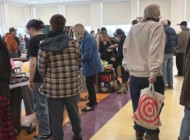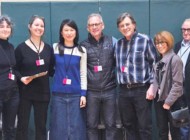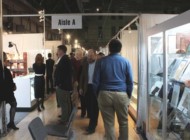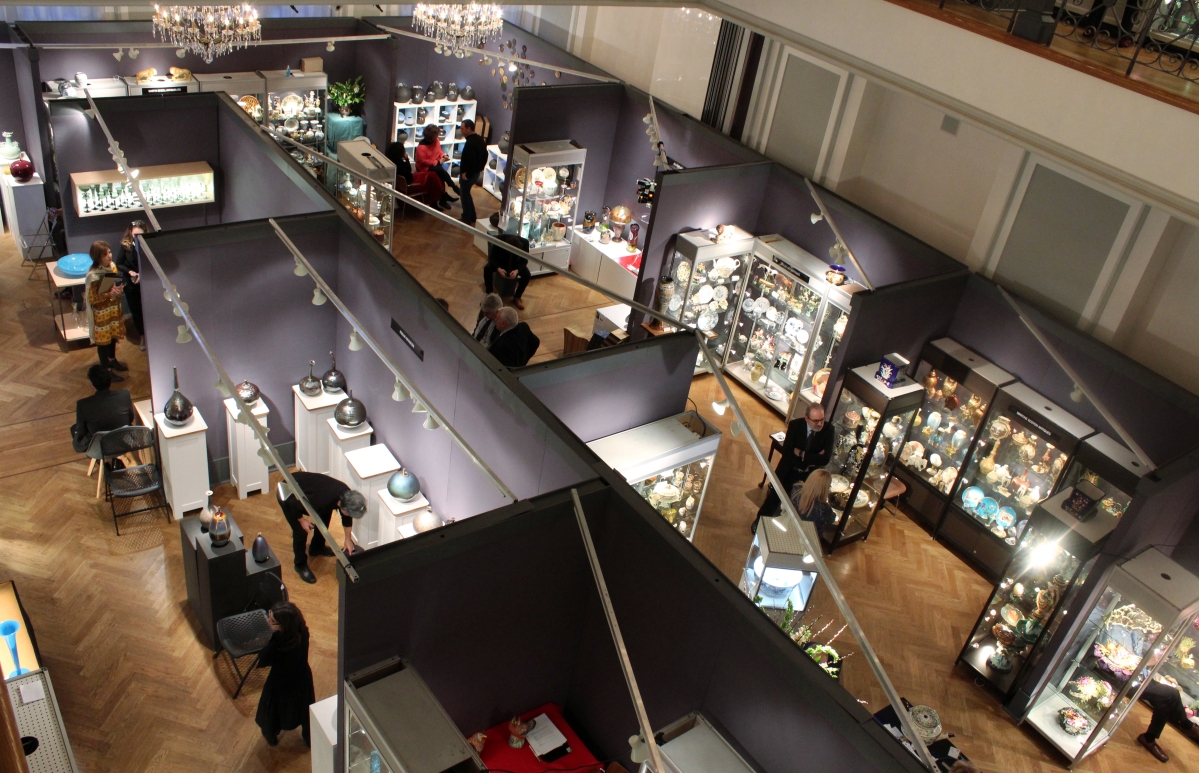
The view of the show from the fifth floor to the fourth is part of the charm of the Bohemian National Hall, which has hosted the event for five years since its move from the National Academy Museum and School.
Review and Photos by W.A. Demers
NEW YORK CITY – The beloved New York Ceramics & Glass Fair, which opened with its preview on January 17 and ran through January 21 at the Bohemian National Hall, extended its 18-year reputation as a jewel box filled to the brim with a mix ranging from contemporary studio pottery by international ceramists to Eighteenth Century Staffordshire with everything under the sun in between.
The event is a colorful, sparkling bazaar, drawing collectors, museum curators and their donors as well as interior designers whose anxiety is almost palpable, faced as they are with the prospect of sampling every banquet that is laid out in the chilly Big Apple during Antiques Week.
Fortunately for them, the fair opened with a preview on Wednesday, a day before the venerable Winter Antiques Show and the major auctions. Even then, show co-producers Meg Wendy of MCG Events LLC and Liz Lees opened the doors a couple of hours earlier than usual so that preview patrons could browse the aisles and then hustle on down to Christie’s for the Wunsch Foundation awards and reception.
The main course at the fair is offered by the 30 dealers with a range of works from antiquity to contemporary. There are many side dishes as well, however, including two loan exhibitions that greet visitors as they step off the elevators into the entrance lobbies of the fourth and fifth floors. This year, on the fourth floor, was “Buried Treasure: New Discoveries in Philadelphia Slipware from the Private Collection of the Museum of the American Revolution.” Robert Hunter, editor of Ceramics in America, archaeologist and ceramic historian, explained how excavations in 2014 of former privies on the Philadelphia museum’s site during its construction yielded a trove of Eighteenth Century pottery shards that when reassembled formed items almost Modernist looking in their design. On the fifth floor space “Revive, Remix, Respond: Contemporary Artists at the New York Ceramics & Glass Fair and the Frick Pittsburgh,” a collaboration by Dawn Brean and Leslie Ferrin, was complemented by a Friday and Saturday lecture series, conversations with exhibiting artists and curators.
Warmer January weather and extensive media coverage – from The New York Times to WQXR – helped send devotees of ceramics and glass to the 19th edition, according to the show promoters. Said Lees, “What was so gratifying this year was that the fair welcomed not only seasoned attendees but a whole new crop of first-time visitors. Word is out: There is always plenty to see, learn about and buy at the New York Ceramics & Glass Fair!”
“We were particularly pleased with the large curator turnout this year,” added Wendy.
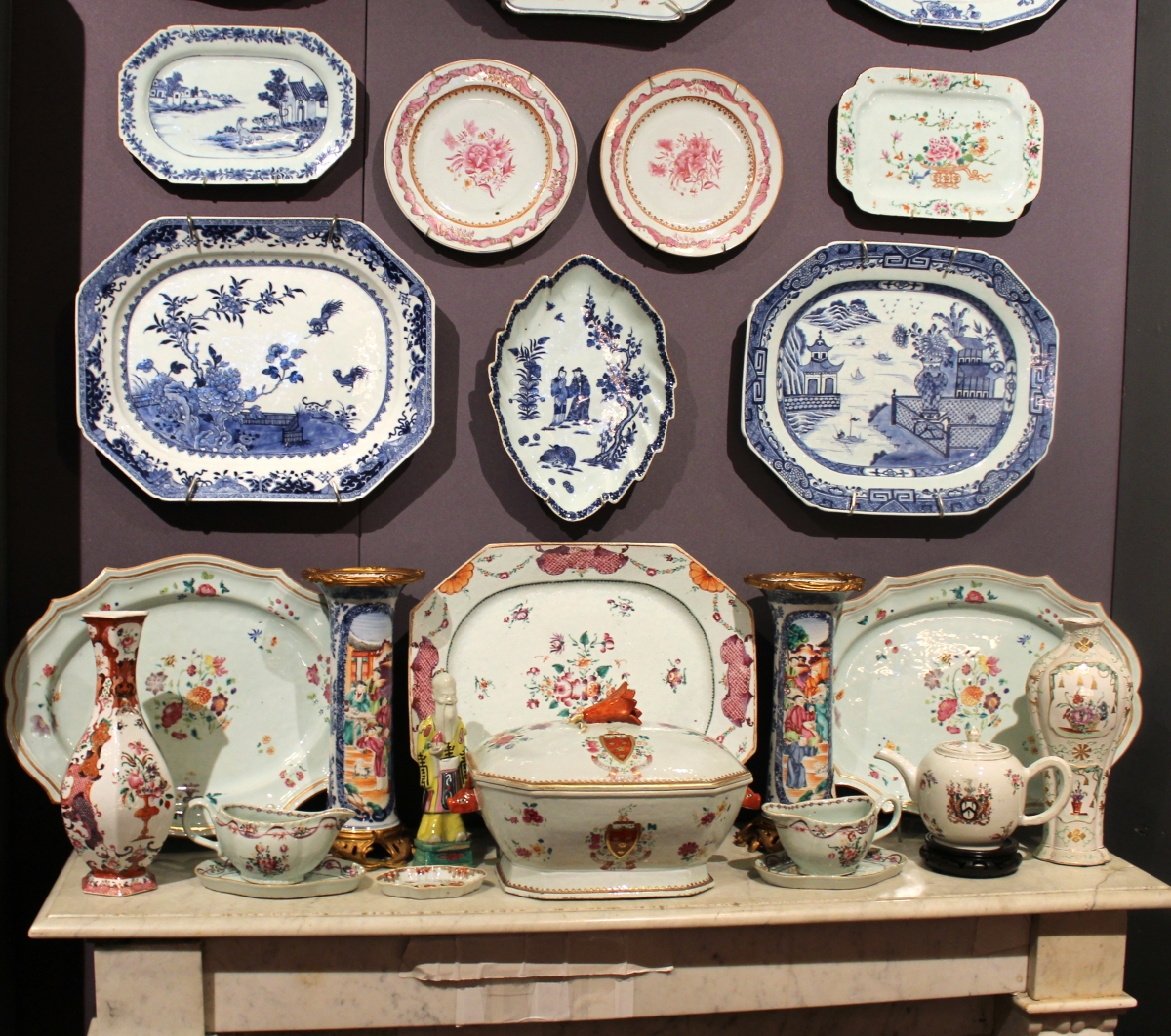
Collection of Chinese export porcelain, including underglaze blue and white, famille rose and armorial examples, shown by Lynda Willauer Antiques, Nantucket, Mass.
As always, the fair is the flame attracting curators from prominent museums across the United States. The list goes on and on, but includes the White House, American Folk Art Museum, the Metropolitan Museum of Art, the Brooklyn Museum of Art, the Museum of Fine Arts, Boston, the Frick Pittsburgh and Smithsonian, just to name a few.
There were many standout sales during the fair and – as is often the case with institutional acquisitions- holds placed on items requiring museum board approvals. Robert P. Walker of Polka Dot Antiques based in Waccabuc, N.Y., bid farewell to a Pilkington’s Royal Lancastrian Daffodil tile from a set of six rare tiles by Walter Crane, and sold a unique illustrated Staffordshire creamware teapot with “Sally Sikes Drinking Tea, 1780” inscribed on it. His research showed that Sally’s last name was really spelled “Sykes” and that the piece had been in the possession of the same family since its manufacture. Genealogical research on a larger teapot revealed that its owner, Ann Wotwood, was actually Ann Watwood, a misspelling that did not spoil the piece’s appeal to Americana buffs, what with the 1776 date.
“I certainly sold four items to museums, after holds placed on items,” said Walker, “two items having three museum holds. I also sold six pieces of British decorative arts. During the week, I sold Whieldon wares, delftwares, a rare early chinoiserie transfer printed tile, named and dated creamwares, even some blue and white porcelain, which has become more and more difficult over the years. The very rare Walter Crane-designed Pilkington’s tile, which was used extensively in the press, didn’t last, selling to a specialist Pilkington’s collector.”
Walker said specific items that drew much interest were a unique Furnival’s Pottery Pattern Book and a vase matching one of the patterns on the pages; a rarely colored Bernard Moore vase molded with low relief fish applied with transfer printed gilt; a Royal Worcester Aesthetic Movement teapot and a Staffordshire flat back called “Fireside Study.” Both pattern books, Furnivals 1900/1913 and Machin & Potts (1830/1835), sold to a museum.
Steady sales were also reported to be the order of the day for Polly Latham, the Boston Asian art dealer with many early American rarities. Among these that sold were an American market teapot with an unusual view of ship flying the American flag and firing a cannon salute, circa 1800, and a American market teapot made by Mehetable Adams, circa 1790-1800. Sold, too, was a Japanese Arita V.O.C. charger in the kraak ware style with an insignia of the Dutch East India Company, circa 1680. Illustrating the aspirational sensibilities of early mid-Atlantic and Southern states Americans, who liked to emulate English lifestyle, was an equestrian-themed punch bowl, circa 1790-1800, featuring sepia roundels after European prints of the period.
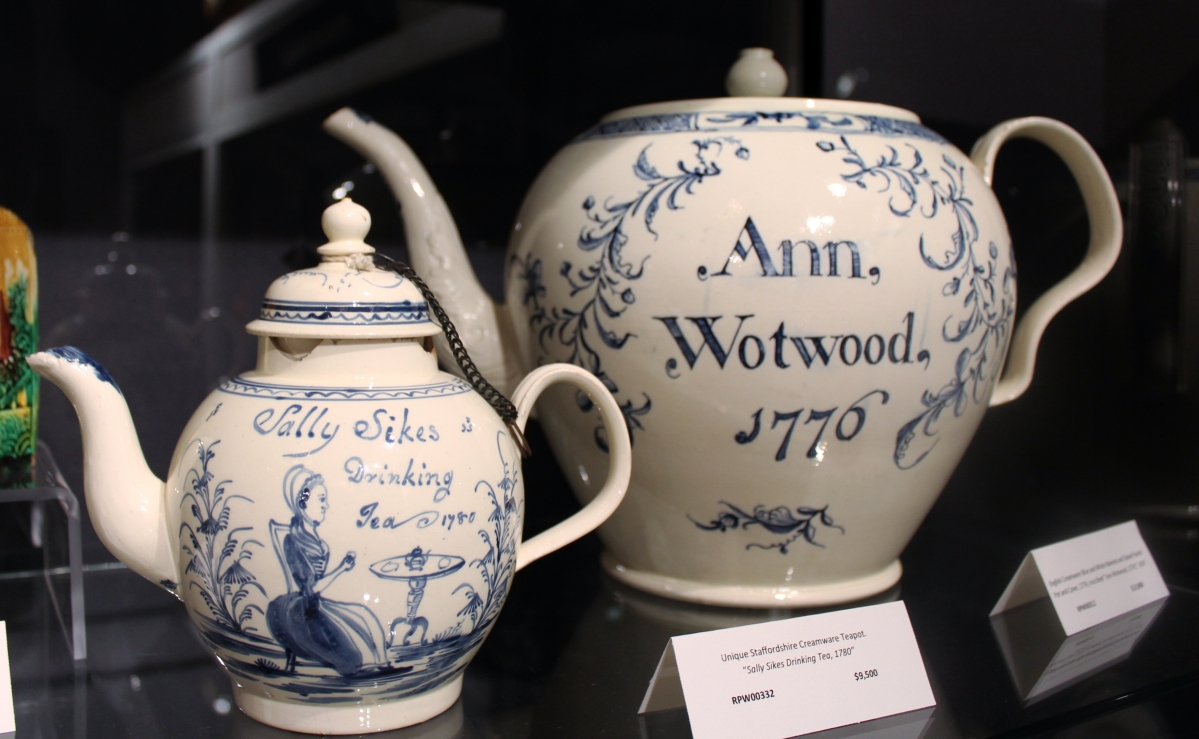
Dealers who carefully research pieces that come into their inventory are often rewarded by interesting revelations. Such was the case when Robert Walker of Polka Dot Antiques, Waccabuc, N.Y., checked the bona fides of these two English creamware pieces — both unique. The small teapot at left is the only example he has seen naming its owner and proclaiming “drinking tea.” Until it came into his hands it had been in the possession of the same family since 1780. Genealogical research on the larger teapot revealed that Ann Wotwood was actually Ann Watwood, a misspelling that did not spoil its appeal, what with the 1776 date.
“We had a great show,” said gallerist Leslie Ferrin of North Adams, Mass.-based Ferrin Contemporary. “Several of our young artists showing with us and at the fair for the first time, Crystal Morey and Evan Hauser, had near sellout shows, as did Australian Stephen Bowers, who got approval for a sale of his work to the Peabody Essex Museum.”
Bowers, who had done some research at the Peabody Essex in 2016, had flown in for the show. He was on hand during the preview, explaining how he synthesizes imagery from antiquity, the natural world and an international design lexicon to fashion his stunning pieces. Thus, for “Ming Meets Morris Meets Macropod,” 2018, which goes into the museum’s collection, Bowers placed a sulphur-crested cockatoo against a background of lobed reserves. The bird holds in its beak a length of blue twisted string from which a decorative bow dangles. Bowers said the cockatoo references classic natural history illustration, while the decorative bow is sourced from Meyer’s Handbook of Ornament. The reserve above the bird’s raised crest is filled with Honeysuckle, a wallpaper design first registered by William Morris in 1883. The border and foliage details are based closely on Ming kraak wares held in the collection of the PEM Salem, in particular, a porcelain charger, 1573-1619, and, finally, the central circular reserve incorporates a rendering of the 1773 George Stubb’s “Kangaroo” – the first clear depiction of this Australian marsupial macropod.
Collectors also sought out Ferrin for “New Symbiosis! Lush Anthesis (Lioness),” 2018, and “Entangled Wonder: Diana with Doe,” 2017, by Morey; a vase by Peter Pincus and Mara Superior’s whimsical blue and white ceramic tiles.
“The response to the ‘Remix, Revive, Reinvent’ preview and special exhibition organized with the Frick Pittsburgh was tremendous,” said Ferrin, “and the two young artists were featured in this exhibition.”
Cambridgeshire dealer Martyn Edgell reported sales that included an agateware teapot, a salt-glaze lighthouse coffer and a large amount of mochaware. Just across the aisle was London early English ceramics specialist Garry Atkins, who said he sold a rare pair of Staffordshire white salt-glaze Figures of Doves, circa 1750, and Seventeenth Century delftware pieces.
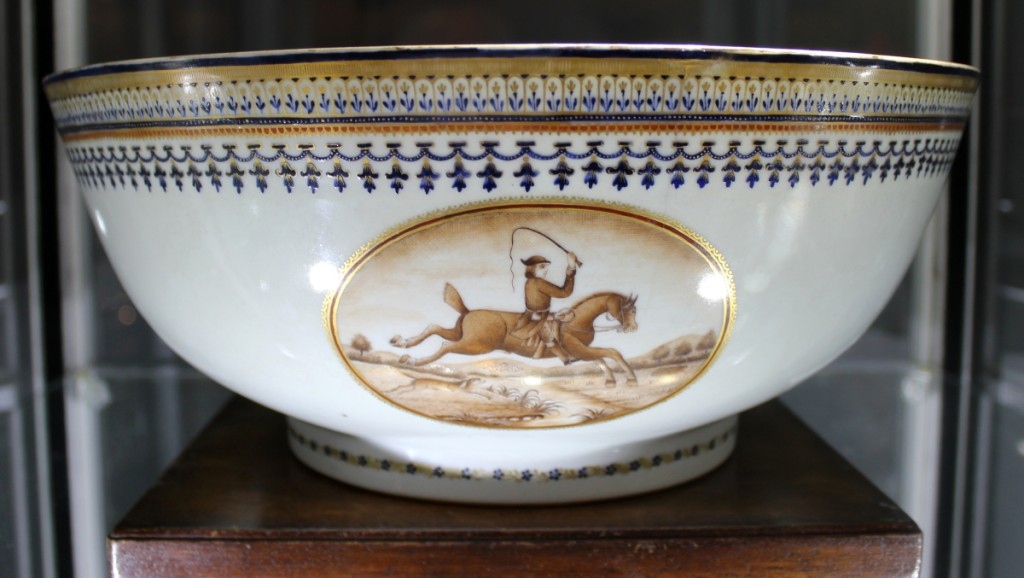
To the hunt! This equestrian-themed punch bowl, circa 1790–1800, featured sepia roundels after European prints of the period. Such pieces were popular in the mid-Atlantic and Southern states, according to Polly Latham, Boston, where an English lifestyle was emulated.
Tailoring her display to speak to “how things are made,” Jill Fenichell, Inc/Bespoke Porcelain Company, Brooklyn N.Y., took up one wall with a selection of French Limoges color sample plates that were snapped up over the weekend. Used to discern how firing affects applied colors, the collection ranged from about 1880 to the mid-1960s. Also on offer was a dichroic lamp by Joe Clearman Studio Glass showing how red tones turn to blue when the lamp is lit and a case full of ceramic figures by various women artists.
The fair’s organizers ticked off additional sales, including New York-based Leo Kaplan, Ltd, who sold numerous floral patterned paperweights and a selection of Eighteenth Century English pottery; Vetro Vero of West Grove, Penn., finding buyers for its selection of hand-blown glass pitchers, bottles, opaline bottles and goblets, and Mark West, from Surrey, England, who reported a good opening night with numerous sales of glass pieces snapped up by collectors, including a Queen Victoria wine glass, circa 1890, engraved “VR,” no doubt getting a lot of “juice” from the popularity of the PBS television series.
“The show went well,” said Cliff Lee, porcelain artist from Stevens, Penn. “It started slow on Saturday, but in the end I sold five pieces,” including to private collectors and museums with new people coming through his stand. Among the pieces sold were a celadon carved vase, a carved yellow hibiscus vessel and a yellow prickly melon vessel.
Newcomer Pascoe and Company, which featured Ardmore Ceramics from South Africa, was delighted to sell more than a dozen pieces of this colorful, one-of-a-kind pottery. “It was a fantastic first-time experience for me,” said Ed Pascoe. “All the right people were here, and it gave me an opportunity to meet serious collectors.”
Katherine Houston, Boston, is best known for her signature porcelain fruits and vegetables, sinuous and exuberant in complex overglaze colors that result from the many firings and reminiscent of the Eighteenth Century. These were snapped up by a number of collectors, who also showed interest in Houston’s more recent “mirage” works, which she describes as “in essence, bas relief images focusing on Greek mythology” She noted that her “jeweled apple” collection continues to sell well.
The fair will return here next January during Antiques Week.
For information, 929-265-2850 or www.nyceramicsandglass.com.





























